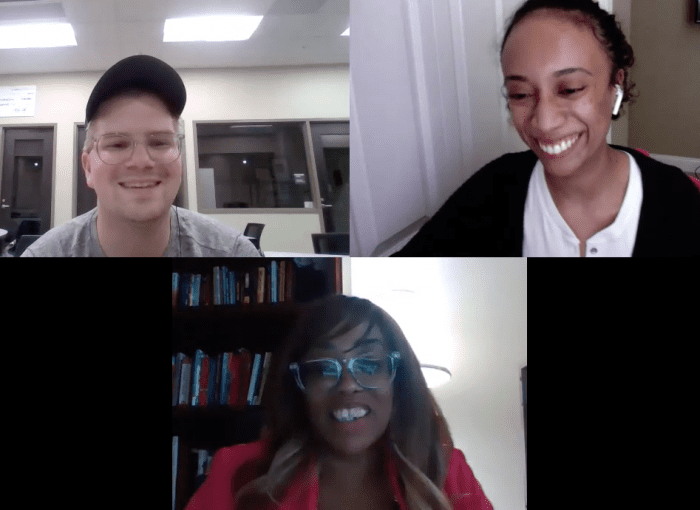By Kealani Smith
How to Talk About Race: An Interview with Dr. Kareem
Taking part in protests, posting black screens on social media, and signing petitions, all mark a social wave that has made an upturn in the discussions we have on race with our families, friends, and even our instructors. We have seen the changes in material within our classrooms regarding racial histories, discourse communities, and even topics such as code-switching being brought up in assigned work. However, we have yet to analyze how our professors have taken a role in guiding these conversations.
While we as students purposefully choose to have these conversations, our professors face the institutions of racism, gender norms, and classism in public education. Not only this, but they must confront these conflicts and social issues in discussions with students. Our professors listen, they observe, and they lay witness to the way social climates storm on campus. In an effort to gain the perspective of professors in the discussion of racial tensions, we spoke to Dr. Kareem, a professor within the DWR program, who emphasizes her course around critical race theory. We appreciate the time and discussion that we had with Dr. Kareem, as she also broadened our perspective on the inner workings of racial tension and discourses.
Critical race theory is the “idea that race is a social construct, and that racism is not merely the product of individual bias or prejudice, but also something embedded in legal systems and policies.” Dr. Kareem constantly regards that “…critical race theory simply gives us the language and tools to speak about race.” The following guide is intended to parallel the way Dr. Kareem uses critical race theory as means to create a space for growth evoking discussion into our own lives.
In our interview, we determined the three most prevalent themes that can be taken as actionable steps by students which include: curiosity, redefining success, and healing within Brown/Black communities.
1. Be Curious
It is reasonable to feel anxious before approaching the topic of race, as it can be polarizing and divisive amongst even the closest of relationships. Dr. Kareem noted that she gets nervous every single time. She emphasizes that “professors are human” and “divisiveness comes from a place of confusion.” Furthermore, the problem with this confusion is that “we have people from across the aisle, who come from a place totally different from us. If you think about these people as only different, not contributory, and not important to these conversations then we are not ever going to move past this place of at least racial division, let alone, gender, and class.”
It is important to understand that this topic will more than likely make the recipient of this conversation uncomfortable or nervous as well, as the topic of race can evoke a high emotional response. Yet, we can demonstrate a less defensive demeanor by simply questioning, “why do you believe this?”
As Dr. Kareem so beautifully regards, “The bottom line is open heart open mind and curiosity; you know, the basic skills that we’re supposed to be learning in academia.”
2. Redefine Success
When we asked Dr. Kareem what defines these successful conversations, she stated that the best dialogue with students is when they are done with “complete and total honesty…. [when students are] willing to not be right all the time, to challenge me from an informed position. Saying here are the problems with this and what do you think about it?”
So often we view success as getting the other to agree with us, or to convince them of our position. Rather, we can make progress by acknowledging the honest truths and experiences of others. This meaning, we remain aware of egos and engage in empathy to understand rather than negotiate. There must be space created in conversation, not for debate but rather listening for understanding the position of the speaker. Our lives and past experiences inform our position and beliefs. Consider success as your own ability to understand and open the controversial and difficult conversation in the first place. Truthfully, we cannot change others with our words but we can lead with understanding to act as an example of tolerance. As Dr. Kareem most strikingly questions, “Why are you so comfortable where you are? So, it is all about analysis and questioning rather than having all the answers. That is the approach we need to have when we talk about these topics and this is how I teach them as well.”
3. From BIPOC to BIPOC
One of the most notable moments of our interview was when I, a person of color, underscored the tension and resentment that congest Brown and Black communities, regarding the perspective of White people in America. As a Brown person, it is normal to feel residual anger or frustration towards White people. We find that resentment undertones our own position in a country and system that is not inherently designed for us. In addressing these issues of resentment and ideas pertaining to race, we can break through this anger and find that there is a common ground to be reached. Only, if we make the space to understand and heal the initial wound itself. Dr. Kareem briefly referenced this idea when speaking on the systemic issues of racism in education, when equating these systemic issues to volcanoes. Dr. Kareem questioned, “You know it wasn’t like the volcano came from nowhere, it was erupting underneath the whole site, it was simmering underneath, there’s this fault line… eventually, it breaks and then things happen, and then we try to fix the cracks but it’s like you didn’t do anything about the thing that created the cracks.”

As we address the issues that created this residual resentment, we heal our communities and can work for the change we wish to see from inside our communities going outward.
This being said, it should still be regarded that there is work to be done, not only in terms of healing for communities of color, but the systemic institutions that do not hold the space to facilitate this healing. Dr. Kareem recalled that if there are, “…15 readings in a semester and five of them were people of color….okay, great. But, when you talked about those readings, did you talk about [these pieces] from the point of view of… I don’t know Aristotle and Faulkner?” This is a small example of how we can open dialogue to the experiences of color. Yet, more can be done in terms of policies. Dr. Kareem also added, “in our classroom policymaking and class thinking about that, but also just systematically thinking, how are we training teachers and how are we keeping up on the professional development, to make sure that those practices stay in place.”
Lastly, Dr. Kareem noted that “critical race theory isn’t perfect.” It is important that these conversations are not perfect. Healing is not an attractive process. A scrape on your body bleeds, it scabs, and the new skin emerges over. In addressing the issue beneath the surface, we should ask questions such as, “Why do you believe this? What do you gain in ignoring race? What do you gain in discussing it?” Asking these questions helps create the momentum needed to create the tolerant environment that UCF so proudly proclaims to be. Whether these conversations occur at home, and you question the beliefs of your family, on-campus with friends, or in the classroom with professors, these conversations are the necessary scab on the sight of the wound, that is the relation between races.





